Simple Remote Control Unit
This is a simple wireless remote control unit, which was originally designed for a model hovercraft which I was developing with the help of my friend Uday Arya. The project has been discontinued for technical reasons, but this remote control unit survives. The method used seems to be quite popular among many remote control units.
Overview

Block Diagram
The controller consists of a Dual-tone multifrequency (DTMF) encoder based on the UM91214 Telephone dialler IC. This versatile chip contains a keyboard matrix scanning section and a dialler. The dialler can be used in both pulse dialling as well as tone dialling modes. We are interested only in tone dialling, since we need the DTMF signals for control. The DTMF signals produced consist of two distinct frequencies summed together. The pair of frequencies is unique for every key on the standard telephone keypad.
The encoded signal is now within the audio band, and can hence be sent to the modulator. The modulator is a commercially available FM microphone kit. Since the microphone kit expects input voltage to be in millivolts, the output of the dialler IC is attenuated. The FM transmitter is set to a frequency of about 100MHz. Operation of this section can be checked by using any FM reciever tuned to the same frequency as the FM transmitter. Pressing any of the buttons attached to the encoder should produce a clear tone in the reciever. If the tone sounds noisy, try tuning the reciever carefully. In case the tone sounds harsh, the reciever may be overmodulating, in which case the attenuation must be increased. If it is too faint, then the attenuation must be reduced. It is better to start with a 10k or 47k pot in place of the resistive divider and adjust this for best reception. Once completed, the pot is disconnected and the resistance measured with a multimeter. The closest available fixed values are then used.
Note that even though provision for a standard telephone keypad is provided, only keys corresponding to 1, 2, 4 and 8 are connected. This is to simplify the decoder circuitry. The dialler IC requires only a 3V supply, hence a simple Zener diode regulator is used to drop the supply voltage to the correct value. The 3.57MHz crystal is easilly available, since it is used in TV colourburst oscillators.
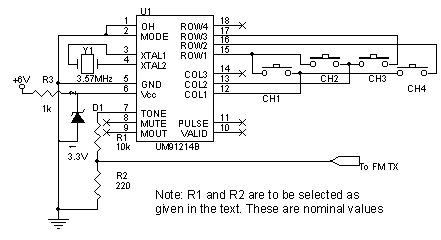
Transmitter
At the reciever side, a commercially available FM reciever kit is used. This provides a good quality audio output. A mono output is sufficient, hence a stereo decoder need not be used. The decoded audio is fed to a KT3170 DTMF decoder chip from Samsung. Similar (not pin-compatible) chips are available from other companies, such as Mitel semiconductor's MT8870. The datasheets for these may be obtained from the respective company websites. The decoder produces a four-bit binary encoded version of the input signal. To simplify the decoder circuitry (which often has to sit within a small space), the outputs are used directly, and no attempt is made to decode them. These outputs are TTL-compatible, and can be used to drive relays, LEDs and other logic circuits.
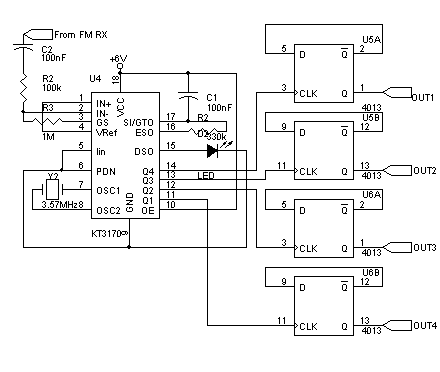
Reciever
The CMOS CD4013 dual D-type latches are used in a toggle fashion, such that their outputs change state whenever the inputs toggle. The latched outputs can then be used directly to drive a logic circuit, or through a transistor driver to switch on or off a small load. A relay can be driven through a transistor driver to control an AC load, such as a lightbulb or a TV. Please take extreme care while constructing circuits dealing with AC voltages. Make sure all high-voltage sections are well insulated. If you have no experience with AC circuits, please seek assistance during construction.
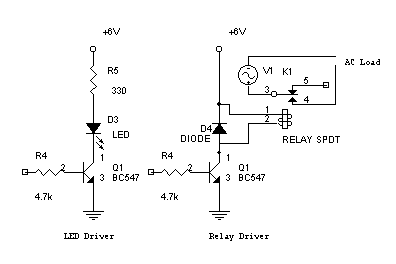
Output Drivers
Construction
This project was constructed mostly on Veroboard, except for the FM transmitter and reciever kits, which had their own custom PCBs. Here is a picture of the transmitter.
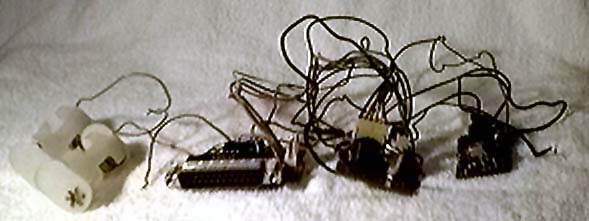
Transmitter
From left to right, it's the battery case, parallel-port interface, main PCB (with the DTMF encoder) and FM Transmitter kit. Parallel port interface makes use of a CD4066 quad analog switch to replace the four switches in the transmitter side. These are then controlled by D0-D3 on the parallel port. Hence, the remotely controlled device can now be under computer control. My test remote control device was this LEGO cart, which could move forwards and backwards, as well as turn on and off it's headlights (Orange LEDs) and rooftop light (Red LED)
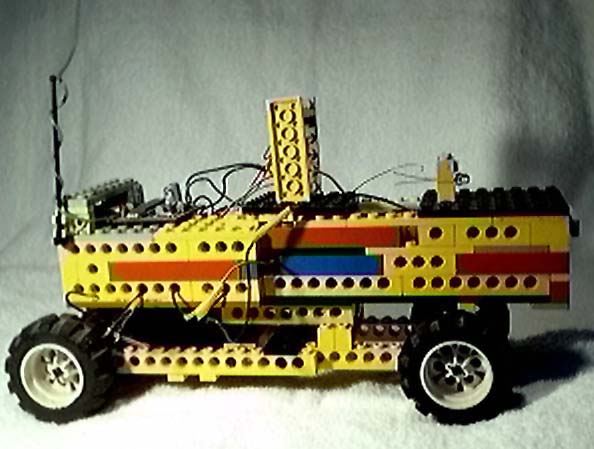
"Buggy!"
Improvements
This system can be extended up to 12 devices by using a 4-to-16 decoder driven by the outputs of the DTMF decoder. The outputs of the decoder may then be used to drive a set of latches in the manner shown above. Of course, the transmitter must be modified to have the full telephone keypad.
Disclaimer
These circuits are provided for your own study only. They all deal with electricity and electronics, a sufficient knowledge of both is assumed. I will not take any responsibility for any personal injury or damage to property arising from use or abuse of the information provided on these pages.





